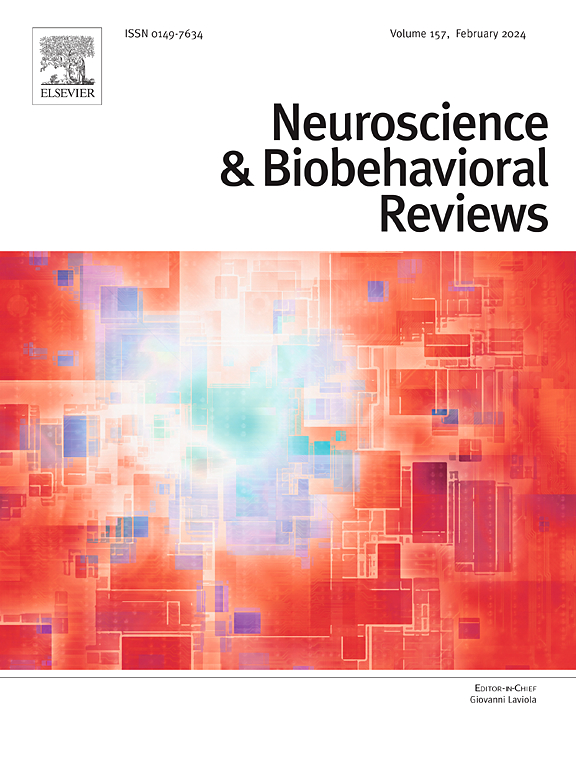Efficacy of non-invasive brain stimulation on theory of mind and emotion processing in neuropsychiatric disorders: A systematic review and meta-analysis
IF 7.9
1区 医学
Q1 BEHAVIORAL SCIENCES
引用次数: 0
Abstract
Social cognitive impairments, including emotion processing (EP) and theory of mind (ToM), have been considered as transdiagnostic features across neuropsychiatric disorders, substantially affecting social functioning. While no definitive treatment exists for these deficits, non-invasive brain stimulation (NIBS) has emerged as a promising option but a comprehensive quantitative review was lacking. This systematic review and meta-analysis were conducted to evaluate the effects of transcranial direct current stimulation (tDCS) and transcranial magnetic stimulation (TMS) on EP and ToM deficits across diverse neuropsychiatric disorders. Following PRISMA guidelines, eligible randomized sham-controlled trials were systematically searched. Hedges’ g was utilized to quantify effect sizes for pretest-posttest-control group designs. A total of 36 studies comprising 1486 participants were included. Meta-analyses revealed a modest yet significant effect of TMS on EP compared to sham (g = 0.295 [95 % CI, 0.065–0.524], p = 0.012), while no significant effects were found for tDCS on EP or ToM, nor of TMS on ToM. Notably, more prominent effects were observed with TMS targeting the left dorsolateral prefrontal cortex (dlPFC) and utilizing facial emotion recognition tasks. However, the high heterogeneity and limited long-term follow-up data call for careful consideration of the durability and consistency of these effects. Potential publication bias was also observed for tDCS on EP. Overall, TMS shows promise for mitigating social cognitive impairments, primarily in EP, but further rigorous investigation is needed to validate its clinical efficacy and long-term benefit. Future research should incorporate large-scale longitudinal studies with neuroimaging and real-world social functioning assessments across disorders.
非侵入性脑刺激对神经精神疾病心理理论和情绪加工的影响:系统回顾和荟萃分析。
社会认知障碍,包括情绪处理(EP)和心理理论(ToM),被认为是神经精神障碍的跨诊断特征,严重影响社会功能。虽然这些缺陷没有明确的治疗方法,但非侵入性脑刺激(NIBS)已成为一种有希望的选择,但缺乏全面的定量评价。本系统综述和荟萃分析旨在评估经颅直流电刺激(tDCS)和经颅磁刺激(TMS)对不同神经精神疾病的EP和ToM缺陷的影响。遵循PRISMA指南,系统检索符合条件的随机假对照试验。采用Hedges' g来量化前测-后测-对照组设计的效应量。共纳入36项研究,1486名参与者。荟萃分析显示,与假手术相比,TMS对EP有适度但显著的影响(g = 0.295 [95% CI, 0.065至0.524],p = 0.012),而tDCS对EP或ToM没有显著影响,TMS对ToM也没有显著影响。值得注意的是,针对左背外侧前额叶皮层(dlPFC)和使用面部情绪识别任务的经颅磁刺激观察到更显著的效果。然而,高异质性和有限的长期随访数据要求仔细考虑这些影响的持久性和一致性。tDCS在EP上的潜在发表偏倚也被观察到。总的来说,经颅磁刺激显示出减轻社会认知障碍的希望,主要是在EP中,但需要进一步严格的研究来验证其临床疗效和长期效益。未来的研究应该结合大规模的纵向研究,包括神经成像和现实世界的社会功能评估。
本文章由计算机程序翻译,如有差异,请以英文原文为准。
求助全文
约1分钟内获得全文
求助全文
来源期刊
CiteScore
14.20
自引率
3.70%
发文量
466
审稿时长
6 months
期刊介绍:
The official journal of the International Behavioral Neuroscience Society publishes original and significant review articles that explore the intersection between neuroscience and the study of psychological processes and behavior. The journal also welcomes articles that primarily focus on psychological processes and behavior, as long as they have relevance to one or more areas of neuroscience.

 求助内容:
求助内容: 应助结果提醒方式:
应助结果提醒方式:


